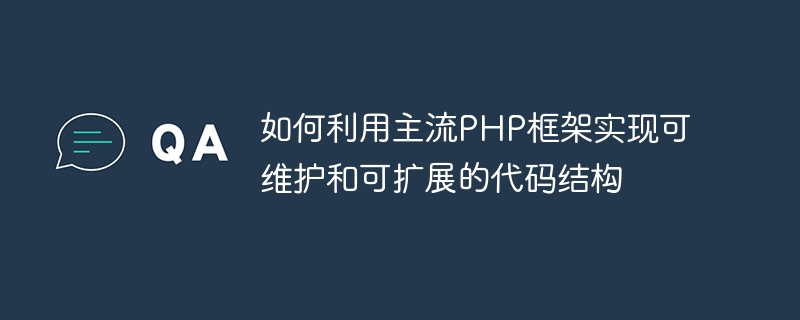Home >Backend Development >PHP Tutorial >How to use mainstream PHP frameworks to achieve maintainable and scalable code structures
How to use mainstream PHP frameworks to achieve maintainable and scalable code structures
- WBOYWBOYWBOYWBOYWBOYWBOYWBOYWBOYWBOYWBOYWBOYWBOYWBOriginal
- 2023-09-05 18:58:441549browse

How to use mainstream PHP frameworks to achieve maintainable and scalable code structures
In the current development environment, using mainstream PHP frameworks to develop applications has become a a common way. These frameworks provide a structured way to organize code so that it becomes maintainable and extensible. This article will introduce how to use mainstream PHP frameworks, such as Laravel and Symfony, to achieve maintainable and extensible code structures.
- Use MVC pattern to organize code
MVC (Model-View-Controller) pattern is a common design pattern and is widely used in PHP frameworks. This pattern divides the application into three parts: Model, View and Controller. Using the MVC pattern can make the code structure clearer and easier to maintain and expand.
The model is the data layer of the application and is responsible for processing data-related logic. The view is the presentation layer of the application and is responsible for presenting data to the user. The controller is the logic layer of the application and is responsible for coordinating the interaction between the model and the view.
The following is a sample code that uses the Laravel framework to implement the MVC pattern:
// UserController.php (控制器)
class UserController extends Controller
{
public function index()
{
$users = User::all(); // 从数据库获取用户数据
return view('users.index', ['users' => $users]); // 将用户数据传递给视图
}
}
// User.php (模型)
class User extends Model
{
protected $table = 'users'; // 指定模型对应的数据库表
}
// index.blade.php (视图)
@foreach ($users as $user)
<p>{{ $user->name }}</p>
@endforeachIn this example, UserController is the controller, responsible for handling user-related logic. User is the model responsible for handling the reading and writing of user data. index.blade.php is the view, responsible for presenting user data to the user.
- Using service containers and dependency injection
Service containers and dependency injection are important concepts in mainstream PHP frameworks that can help achieve code scalability and flexibility.
The service container can be understood as a container used to manage and parse various services in the application. By centralizing the logic for instantiating and binding services in a container, code decoupling and scalability can be achieved.
Dependency injection is a method of removing dependencies from code. Through dependency injection, you can pass an object as a parameter wherever you need to use it, instead of instantiating it directly in the code. This can reduce the coupling of the code and improve the maintainability of the code.
The following is a sample code that uses the Symfony framework to implement dependency injection:
// UserController.php (控制器)
class UserController extends AbstractController
{
private $userService;
public function __construct(UserService $userService)
{
$this->userService = $userService;
}
public function index()
{
$users = $this->userService->getAllUsers();
return $this->render('users/index.html.twig', ['users' => $users]);
}
}
// UserService.php (服务)
class UserService
{
private $userRepository;
public function __construct(UserRepository $userRepository)
{
$this->userRepository = $userRepository;
}
public function getAllUsers()
{
return $this->userRepository->getAll();
}
}
// UserRepository.php (存储库)
class UserRepository
{
public function getAll()
{
// 获取所有用户数据的实现逻辑
}
}
// index.html.twig (视图)
{% for user in users %}
<p>{{ user.name }}</p>
{% endfor %}In this example, UserController depends on UserService, and UserService depends on UserRepository. Through dependency injection, decoupling and maintainability of these objects can be achieved.
- Use routing and middleware to implement request processing
Routing and middleware are important concepts in the mainstream PHP framework and can help implement request processing and control.
Routing can be understood as a URL mapping table that associates the requested URL with the corresponding processing logic. By defining routing rules, requests can be distributed to different controllers and methods.
Middleware is a filter that is executed during request processing. By defining middleware, you can perform some additional processing before or after the request reaches the controller, such as authentication, logging, etc.
The following is a sample code that uses the Laravel framework to implement routing and middleware:
// web.php (路由文件)
Route::get('/users', 'UserController@index')->middleware('auth');
// UserController.php (控制器)
class UserController extends Controller
{
public function index()
{
$users = User::all();
return view('users.index', ['users' => $users]);
}
}
// VerifyUserMiddleware.php (中间件)
class VerifyUserMiddleware
{
public function handle($request, Closure $next)
{
if (Auth::user()->isAdmin()) {
return $next($request);
} else {
return redirect('/login');
}
}
}In this example, the routing file web.php maps the GET /users request to the UserController's index method. This route uses the VerifyUserMiddleware middleware for authentication.
By using routing and middleware, requests can be processed more flexibly and some additional processing can be achieved.
To sum up, using the mainstream PHP framework can achieve a maintainable and scalable code structure. By adopting the MVC pattern to organize code, using service containers and dependency injection, and using routing and middleware, the code can be made clearer, maintainable, and extensible. I hope this article will be helpful to you when developing applications using mainstream PHP frameworks.
The above is the detailed content of How to use mainstream PHP frameworks to achieve maintainable and scalable code structures. For more information, please follow other related articles on the PHP Chinese website!

